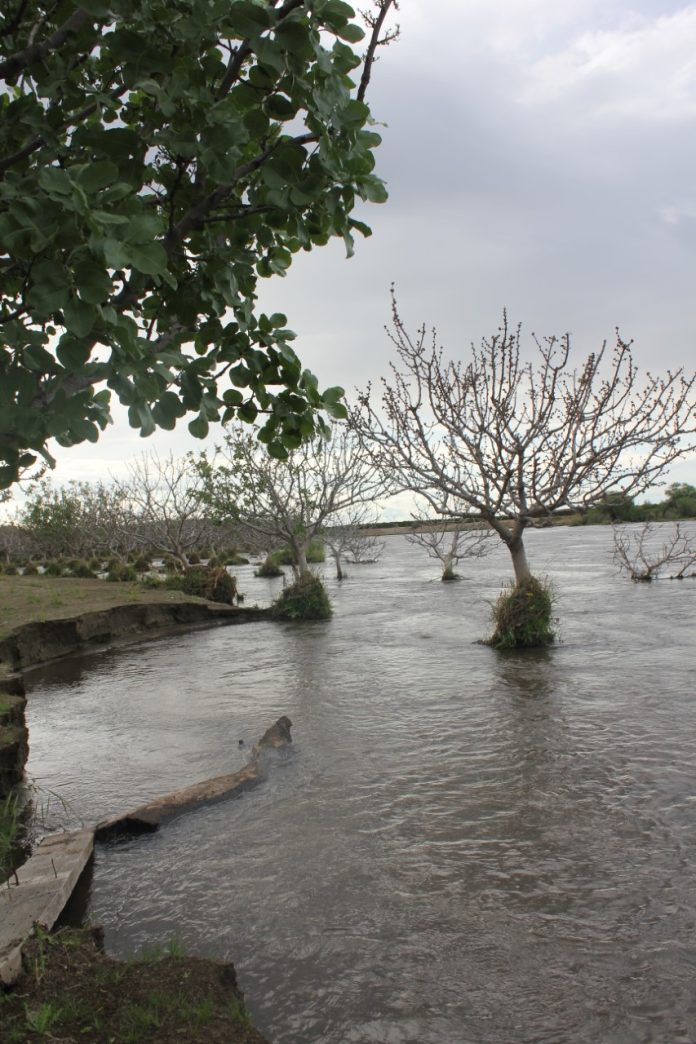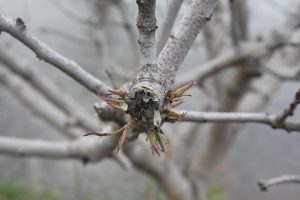
Mother nature may have just given you extra time to start your fertigation plan without a direct yield consequence this season because tree phenology was also delayed the first month after bloom.”
Sebastian Saa, Almond Board of California’s associate director of agricultural research, summed up the first few months of 2023.
Adjustments in many management programs may be in store for many tree nut growers this year. Fertigation is one place that could see some management changes as the growing season progresses.
“Look at your trees first.” Saa said. Before spending money on soil samples, he said insightful observation of trees (new growth, shoot and leaf color) can give early indications of how rain events and, in some cases, flooding, may have affected orchards and their nutritional status. In-season tree response to nutrition applications should be obvious with vigorous vegetative growth, but, if the crop is light, the amount of nitrogen can be reduced. Yield estimates made more often and earlier with precision can allow for changes in fertigation.
Saa said a close look at the developing crop can allow for adjustments including reduction of nitrogen.
Early yield estimates will be key in avoiding a ‘free lunch’ to trees, giving them nutrients they do not need to sustain a light crop.
Early season N demand and timing should be based on yield and three phenology factors. The first application should start just after 70% leaf-out. Fertigate only when the orchard has recovered from flooding. Saa advised running the system for the shortest amount of time possible to avoid saturating the soil. The set should only run for a few hours at a time depending on soil. He suggested running the system now for a few hours first and another few hours in a week. If soils are saturated or if the system can’t be operated for a short period of time, he said a foliar application could be done.
Lower-than-expected yields may mean that trees will use their stored nutrients for a longer period, Saa said.
Next Season Plans
Cover crops and/or soil amendments for next season should be considered to reduce impacts of flooding as well as facilitate re-entry into the orchards. Those inputs may also reduce the likelihood of diseases such as Phytophthora. Excess water in orchards is expected to cause disease problems. As weather warms, Phytophthora symptoms are expected to build. In March, some trees were already experiencing signs of infection. Saa said where trees were in saturated ground, symptoms can appear early or into next year.
Curt Pierce, area irrigation and water resources advisor in Tehama County, said flooded orchard soils can lead to root death depending on tree species, soil type and length of submergence. Recovery times can be extensive. Increased disease/fungal/pest pressure can also be expected in such situations.
If the soil type allows for rapid enough infiltration past the effective root depth of the trees, the main concerns become more about loss of inputs such as nutrients to the deeper soil profiles. Of course, he said, this can be a benefit if salts are a problem, and many producers will sometimes use irrigation waters for this leaching effect.
Pierce said another issue with the winter flooding was salts being pushed back up into the effective root depth of orchards by rising water tables, causing injury to new tree growth.
“That’s something I think some folks may not have been expecting after so many years of drought conditions,” he said.
UCCE farm advisors are reporting numerous calls about diseases that are showing up in orchards that had standing water. Elizabeth Fichtner, Tulare County farm advisor, noted waterborne plant pathogens were affecting orchards impacted by standing water (see related article in this issue of West Coast Nut.) She said over time, the oxygen in saturated soils will be depleted and anoxic conditions can lead to root mortality.
It may take some time before the full extent of the damage is seen, but general canopy decline and anchorage issues may be the first signs of damage.
Even tree nut crops grown on disease-resistant rootstocks may be affected. Phytophthora spp., a group of soilborne pathogens that create motile spores that swim at the water surface, is suspected to be widespread throughout most growing regions. The pathogens can cause canker diseases particularly when water moves above the graft union. Fichtner said the full impact may not be realized until later in the year when higher temperatures add more stress to trees.
She emphasized that growers and farm managers should work with their crop consultants, pest control advisors and UCCE farm advisors to observe and document orchard changes over the growing season.

Janine Hasey, UCCE farm advisor emerita, conducted research following the flooding of numerous walnut orchards in northern California in 2017. She said in many orchards, the extent of flood damage was not evident until 2018. Trees often died or declined in a random pattern, or they died in areas with shallower water tables or longer periods of flooding. Her recommendation to minimize losses in flood impacted orchards where trees are infected with aerial Phytophthora is to leave trees that remain economically productive. Phosphite treatments were found to suppress canker expansion caused by Phytophthora. Trees killed by Phytophthora should be replaced with clonal Paradox RX1 rootstock, which offers resistance to the pathogen. Growers planting walnut orchards in flood-prone areas should also use potted RX1 trees and field bud or graft as high as possible to avoid aerial Phytophthora infections.
Glenn County walnut grower Leslie Nerli noted while her orchards flooded for several days, the water was moving, and she did not expect long-term impacts as the moving water created oxygen for the trees. The moving water brought along wood debris, depositing it in the orchard. Removing wood debris from the orchard and re-working the floors were unplanned spring chores.

Cecilia Parsons | Associate Editor
Cecilia Parsons has lived in the Central Valley community of Ducor since 1976, covering agriculture for numerous agricultural publications over the years. She has found and nurtured many wonderful and helpful contacts in the ag community, including the UCCE advisors, allowing for news coverage that focuses on the basics of food production.
She is always on the search for new ag topics that can help growers and processors in the San Joaquin Valley improve their bottom line.
In her free time, Cecilia rides her horse, Holly in ranch versatility shows and raises registered Shetland sheep which she exhibits at county and state fairs during the summer.















